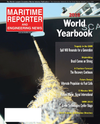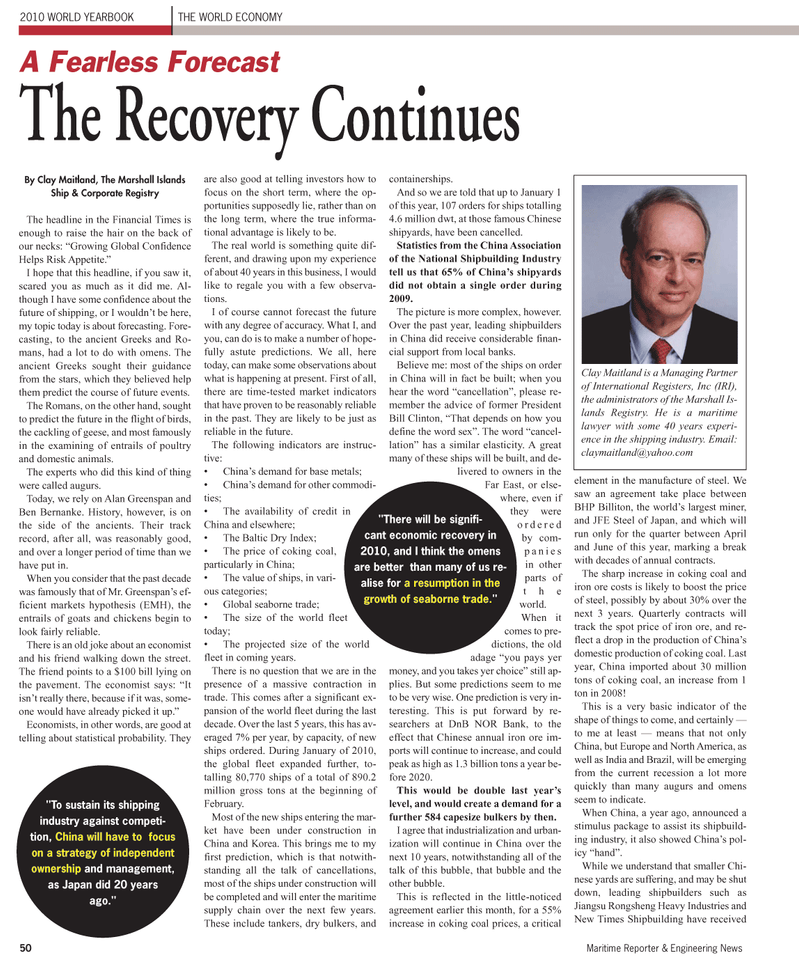
Page 50: of Maritime Reporter Magazine (June 2, 2010)
Read this page in Pdf, Flash or Html5 edition of June 2, 2010 Maritime Reporter Magazine
By Clay Maitland, The Marshall Islands
Ship & Corporate Registry
The headline in the Financial Times is enough to raise the hair on the back of our necks: “Growing Global Confidence
Helps Risk Appetite.”
I hope that this headline, if you saw it, scared you as much as it did me. Al- though I have some confidence about the future of shipping, or I wouldn’t be here, my topic today is about forecasting. Fore- casting, to the ancient Greeks and Ro- mans, had a lot to do with omens. The ancient Greeks sought their guidance from the stars, which they believed help them predict the course of future events.
The Romans, on the other hand, sought to predict the future in the flight of birds, the cackling of geese, and most famously in the examining of entrails of poultry and domestic animals.
The experts who did this kind of thing were called augurs.
Today, we rely on Alan Greenspan and
Ben Bernanke. History, however, is on the side of the ancients. Their track record, after all, was reasonably good, and over a longer period of time than we have put in.
When you consider that the past decade was famously that of Mr. Greenspan’s ef- ficient markets hypothesis (EMH), the entrails of goats and chickens begin to look fairly reliable.
There is an old joke about an economist and his friend walking down the street.
The friend points to a $100 bill lying on the pavement. The economist says: “It isn’t really there, because if it was, some- one would have already picked it up.”
Economists, in other words, are good at telling about statistical probability. They are also good at telling investors how to focus on the short term, where the op- portunities supposedly lie, rather than on the long term, where the true informa- tional advantage is likely to be.
The real world is something quite dif- ferent, and drawing upon my experience of about 40 years in this business, I would like to regale you with a few observa- tions.
I of course cannot forecast the future with any degree of accuracy. What I, and you, can do is to make a number of hope- fully astute predictions. We all, here today, can make some observations about what is happening at present. First of all, there are time-tested market indicators that have proven to be reasonably reliable in the past. They are likely to be just as reliable in the future.
The following indicators are instruc- tive: • China’s demand for base metals; • China’s demand for other commodi- ties; • The availability of credit in
China and elsewhere; • The Baltic Dry Index; • The price of coking coal, particularly in China; • The value of ships, in vari- ous categories; • Global seaborne trade; • The size of the world fleet today; • The projected size of the world fleet in coming years.
There is no question that we are in the presence of a massive contraction in trade. This comes after a significant ex- pansion of the world fleet during the last decade. Over the last 5 years, this has av- eraged 7% per year, by capacity, of new ships ordered. During January of 2010, the global fleet expanded further, to- talling 80,770 ships of a total of 890.2 million gross tons at the beginning of
February.
Most of the new ships entering the mar- ket have been under construction in
China and Korea. This brings me to my first prediction, which is that notwith- standing all the talk of cancellations, most of the ships under construction will be completed and will enter the maritime supply chain over the next few years.
These include tankers, dry bulkers, and containerships.
And so we are told that up to January 1 of this year, 107 orders for ships totalling 4.6 million dwt, at those famous Chinese shipyards, have been cancelled.
Statistics from the China Association of the National Shipbuilding Industry tell us that 65% of China’s shipyards did not obtain a single order during 2009.
The picture is more complex, however.
Over the past year, leading shipbuilders in China did receive considerable finan- cial support from local banks.
Believe me: most of the ships on order in China will in fact be built; when you hear the word “cancellation”, please re- member the advice of former President
Bill Clinton, “That depends on how you define the word sex”. The word “cancel- lation” has a similar elasticity. A great many of these ships will be built, and de- livered to owners in the
Far East, or else- where, even if they were ordered by com- panies in other parts of the world.
When it comes to pre- dictions, the old adage “you pays yer money, and you takes yer choice” still ap- plies. But some predictions seem to me to be very wise. One prediction is very in- teresting. This is put forward by re- searchers at DnB NOR Bank, to the effect that Chinese annual iron ore im- ports will continue to increase, and could peak as high as 1.3 billion tons a year be- fore 2020.
This would be double last year’s level, and would create a demand for a further 584 capesize bulkers by then.
I agree that industrialization and urban- ization will continue in China over the next 10 years, notwithstanding all of the talk of this bubble, that bubble and the other bubble.
This is reflected in the little-noticed agreement earlier this month, for a 55% increase in coking coal prices, a critical element in the manufacture of steel. We saw an agreement take place between
BHP Billiton, the world’s largest miner, and JFE Steel of Japan, and which will run only for the quarter between April and June of this year, marking a break with decades of annual contracts.
The sharp increase in coking coal and iron ore costs is likely to boost the price of steel, possibly by about 30% over the next 3 years. Quarterly contracts will track the spot price of iron ore, and re- flect a drop in the production of China’s domestic production of coking coal. Last year, China imported about 30 million tons of coking coal, an increase from 1 ton in 2008!
This is a very basic indicator of the shape of things to come, and certainly — to me at least — means that not only
China, but Europe and North America, as well as India and Brazil, will be emerging from the current recession a lot more quickly than many augurs and omens seem to indicate.
When China, a year ago, announced a stimulus package to assist its shipbuild- ing industry, it also showed China’s pol- icy “hand”.
While we understand that smaller Chi- nese yards are suffering, and may be shut down, leading shipbuilders such as
Jiangsu Rongsheng Heavy Industries and
New Times Shipbuilding have received 2010 WORLD YEARBOOK THE WORLD ECONOMY
A Fearless Forecast
The Recovery Continues
Clay Maitland is a Managing Partner of International Registers, Inc (IRI), the administrators of the Marshall Is- lands Registry. He is a maritime lawyer with some 40 years experi- ence in the shipping industry. Email: [email protected] "There will be signifi- cant economic recovery in 2010, and I think the omens are better than many of us re- alise for a resumption in the growth of seaborne trade." "To sustain its shipping industry against competi- tion, China will have to focus on a strategy of independent ownership and management, as Japan did 20 years ago." 50 Maritime Reporter & Engineering News

 49
49

 51
51
